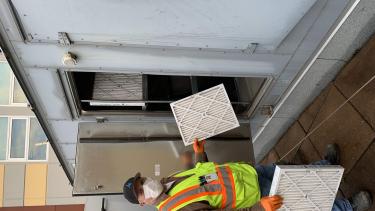
MERV 13 Filters
Most of you have probably heard of MERV 13 filters, but have you ever wondered why they are called “MERV 13” and how they work?
As air moves through a building’s HVAC system, air filters trap and collect large and small particles such as dust, allergens, and microorganisms. According to ASHRAE (American Society of Heating, Refrigerating and Air-Conditioning Engineers), this filtration helps provide healthier indoor air quality. A filters MERV number indicates how it’s rated to remove these particles. But what is a MERV rating exactly?
A MERV rating is an air filters “Minimum Efficiency Reporting Value” that measures how effectively the filter stops dust and other contaminants from passing through the filter and into the air stream. Filters with higher MERV ratings trap small particles more effectively than filters with lower MERV ratings.
When selecting the right filter for your application, higher is not always better. Using an air filter with a MERV rating higher than what the equipment manufacturer recommends can impair its performance. The smaller pores in more highly rated air filters create resistance to air flow. If the system is not designed to handle this resistance, it can lower the systems efficiency, decrease indoor air quality, and put strain on the systems fan.
In the Spring of 2021, the district implemented a MERV 13 trial at 5 of our sites. These sites were then monitored to see what or if any impacts the MERV 13 may have on our HVAC systems. Once we determined there would be minimal, negative impacts, we started implementing these filters into our filter replacement schedule. MERV 13 has since become the new district standard for filters. We currently have MERV 13 filters in approximately 80% of our sites with minimal issues. This project is scheduled to be 100% complete by Spring Break.
Our Filter Specialist, Tony Tanner fully dedicates each day to changing filters according to the preventive maintenance schedules in place. You may have noticed Tony (or at least his legs on the ladder) as he climbs into the roof top units or squeezes in and around T-bar ceilings. There are approximately 2,850 filters at 47 sites that require changing on a quarterly basis. Some of these units can be challenging to access due to their location on roof tops or in tight Mechanical rooms.
For more information or to check your site’s VSO, please go to the Workplace Safety SharePoint Page.